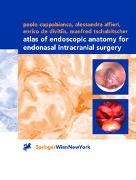Read more
It is only recently that the use of the endoscope as the sole visualizing tool has been introduced in transsphenoidal pituitary surgery with its favorable related implications and minimal operative trauma. Of course, microscopic and endoscopic anatomy are basically the same, but the optical distorsion of endoscopic images is quite substantial compared to microscopic depictions. An endoscope lens produces images with maximal magnification at its center and severe contraction at its periphery. Nearer images are disproportionally enlarged and remote images are falsely miniaturized. This optical illusion may disorientate a surgeon who is not familiar with this peculiar condition at the skull base.This atlas acts as a guide through the endoscopic anatomy and gives detailed descriptions of the preoperative management and the surgical procedures.
List of contents
I. Anatomic preparations.- I.A. Gross anatomy.- I.A.1. Bone preparations.- I.A.2. Nose and paranasal sinuses.- I.B. Endoscopic surgical anatomy.- I.B.1. Nose.- I.B.2. Sphenoidal sinus.- I.B.3. Sella turcica region.- I.B.4. Suprasellar region.- I.B.5. Parasellar region.- I.B.6. Retrosellar region.- II. Preoperative management.- II.A. Neuroradiological investigations.- II.A.1. CT.- II.A.2. MRI.- II.B. Operating theatre.- II.B.1. Positioning of the patient.- II.B.2. Equipment.- III. Surgical procedure.- III.A. Surgical steps.- III.A.1. Endonasal approach to the sphenoidal sinus ostium.- III.A.2. Enlargement of the sphenoidal sinus ostium.- III.A.3. Preparation of the sphenoid sinus.- III.A.4. Opening of the floor of the sella turcica.- III.A.5. Opening of the dura mater.- III.A.6. Removal of the lesion.- III.A.7. Sella turcica reconstruction.- Appendix: Selected clinical cases.- Case 1: Intra-suprasellar macroadenoma.- Case 2: Intra-parasellar macroadenoma.- Case 3: Solid intra-suprasellar craniopharyngeoma.- Case 4: Cystic intra-suprasellar craniopharyngeoma.- Case 5: Arachnoid intra-suprasellar cyst.- Case 6: Intra-suprasellar RATHKE s cleft cyst.- References.
Summary
It is only recently that the use of the endoscope as the sole visualizing tool has been introduced in transsphenoidal pituitary surgery with its favorable related implications and minimal operative trauma. Of course, microscopic and endoscopic anatomy are basically the same, but the optical distorsion of endoscopic images is quite substantial compared to microscopic depictions. An endoscope lens produces images with maximal magnification at its center and severe contraction at its periphery. Nearer images are disproportionally enlarged and remote images are falsely miniaturized. This optical illusion may disorientate a surgeon who is not familiar with this peculiar condition at the skull base. This atlas acts as a guide through the endoscopic anatomy and gives detailed descriptions of the preoperative management and the surgical procedures.
Additional text
"... Den Autoren ist ein vom ausgezeichneten Bildmaterial dominierter Atlas gelungen ... " Annals of Anatomy 185/5/2003

